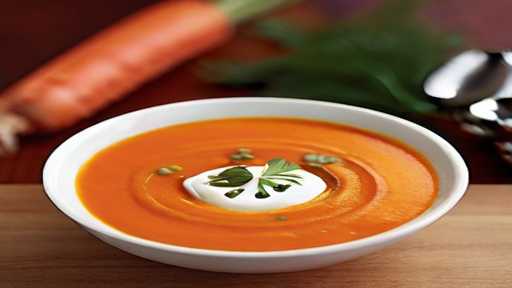How to Cook Fiery Thai Red Curry with Vegetables: An Ensemble of Flavors
Enjoy a vibrant variety of Thai Red Curry with Vegetables. A work of culinary art that perfectly combines the richness of coconut milk with the brightness of red curry gluten. This aromatic dish features a variety of fresh, beautiful vegetables washed with sweet and savory sauces, creating an ensemble of flavors that will delight your taste buds. Packed with Thai spices and flavours, this vegan magic offers the ideal balance of rich, sour and exquisite aromas, making it a delicious foray into the heart of Thai cuisine.
The Origin of Thai Red Curry
Vegetable red curry, which originated in Thailand, is a sweet and delicious dish with a dynamic red color and rich flavor. This dish usually consists of a mixture of fresh vegetables, such as bell peppers, carrots, and bamboo shoots, cooked in a delicious curry sauce made with red bean stew, coconut milk, and a mixture of spices and flavors. This delicious and famous Thai dish reflects the country’s culinary mastery, combining sweet, savory and exquisite flavors in a pleasing balance, delighting palates around the world.
What is Thai red curry with vegetables?
Thai red curry with vegetables is a fragrant and delicious Thai dish. It is characterized by a rich curry made with coconut milk as a base, red bean stew, lemongrass, ginger, and garlic. A dynamic combination of vegetables such as peppers, broccoli and carrots creates a striking and spicy curry embodiment, creating a pleasant combination of ingredients and flavours. This famous Thai dish offers a wonderful combination of intensity, comfort and tenderness, making it a worthy choice for veggie lovers and those looking for a heavenly and fulfilling vegetarian feast.
Ingredients for Thai Red Curry with Vegetables:
- For Red Curry Paste :
- • 3-4 Thai red chilies, seeds removed (according to taste preference)
- • 2 shallots, peeled
- • 3 garlic cloves, peeled
- • 1 lemongrass tail, white part only, sliced
- • 2.5 cm galangal or ginger, peeled and sliced
- • 1 teaspoon coriander seeds
- • 1/2 teaspoon cumin seeds
- • 1/2 teaspoon salt
- • 1 tablespoon tomato paste
- • 2 tablespoons vegetable oil
- For the curry:
- • 1 can (14 oz.) coconut milk
- • 2 tablespoons red curry paste (fine sauce) )
- • 1 tablespoon vegetable oil
- • 1 onion, finely chopped
- • 1 bell pepper, sliced
- • 1 zucchini, sliced
- • 1 carrot, shredded
- • 1 cup broccoli florets
- • 1 cup snap peas , managed
- • 1 block (14 oz) of firm tofu, diced (good protein)
- • 2 tablespoons soy sauce
- • 1 tablespoon sugar
- • 1 lime, squeezed
- • New coriander leaves, for garnish
- • Cooked jasmine Rice, for serving
- Substitutes: Thai Red Curry
- • If you don’t have fresh lemongrass, use 1 tablespoon lemongrass paste or 1 teaspoon lime zest instead.
- • If galangal is not open, you can replace galangal with ginger.
- • Substitute firm tofu with chicken, shrimp, or your favorite protein.
- • Use light coconut milk for a low-fat version.
- • Any combination of bright vegetables can be used, depending on personal inclinations and accessibility.
Kitchen tools and equipment: Thai Red Curry with Vegetables
- 1. Cutting board and knife:
- • For chopping vegetables and planning different types of preparations. To do something.
- 2. Wok or platter:
- • For cooking and frying ingredients, vegetables, and curry.
- 3. Wooden spoon or spatula:
- • Used to mix and mix ingredients in a wok or bowl.
- 4. Can Opener:
- • Assume you are using canned coconut milk or other canned ingredients.
- 5. Spoon/cup for estimation:
- – For accurate estimation of taste, curry paste, and various ingredients.
- 6. Garlic Press:
- • When a recipe calls for mincing garlic.
- 7. Grater:
- – For grating fresh ginger and other ingredients.
- 8. Pot or rice cooker:
- • For serving curry while cooking rice.
- 9. Vegetable peeler:
- – For peeling and slicing vegetables.
- 10. Strainer:
- • When a recipe calls for using up or rinsing ingredients such as tofu or vegetables.
- 11. Ladle:
- • For serving curry.
- 12. Bowls and Plates:
- • To serve individual segments.
- 13. Chopsticks or forks:
- • Cutlery.
- 14. Canister or mortar and pestle:
- • Suppose you make Thai red curry paste yourself without any preparation.
- 15. Citrus Press:
- • For squeezing the juice of limes and other natural citrus products.
- 16. Tongs:
- • Used for handling and turning food in woks and pots.
- 17. Edible oil and brush:
- – For covering woks and bowls and for cooking.
- 18. Crock Pot:
- • Suppose you really want to stew or make an additional sauce.
- 19. Container of fish sauce or soy sauce:
- • Add these sauces to the curry.
- 20. Rice Serving Spoon:
- • Intended for serving rice with curry.
Cooking Directions: Thai Red Curry with Vegetables
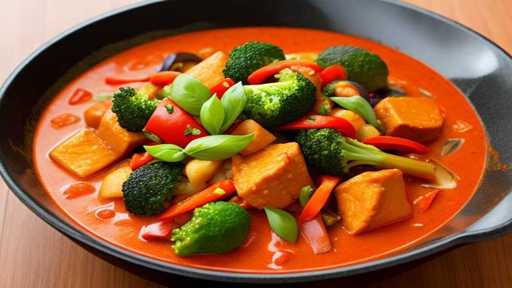
- Preparation:
- 1. Cut the vegetables: Wash the mixed vegetables and cut them into small pieces. Please put it away.
- 2. Prepare the fragrance. Finely chop the garlic and crush the ginger. Be prepared for cooking.
- 3. Preheat the dish: Heat the vegetable oil in a large pot or wok over medium-high heat.
- 4. Stir-fry to taste: Add minced garlic and grated ginger to hot oil. Stir-fry for 1-2 minutes until fragrant.
- 5. Add red curry paste. Add the red curry paste and mix well to combine the flavors. Cook for another 2 minutes.
- 6. Stir-fried vegetables: Add the cut vegetables to the container. Pan-fry for 3 to 5 minutes, until tender and the surface is fresh.
- 7. Coconut milk: Pour coconut milk and mix with vegetables and curry paste. Transfer the mixture to a light stew.
- 8. Spices: Add soy sauce, sugar and lime juice to the dish. Mix well to keep the flavor even.
- 9. Simmer: Reduce the heat to low and simmer the curry for 10-15 minutes to blend the flavors and cook the vegetables.
- 10. Taste and Vary: Taste the curry and modify the taste by adding more soy sauce, sugar, or lime juice as needed.
- 11. To serve: Once the vegetables have softened and the curry has thickened slightly, remove the pot from the heat.
- 12. Garnish: Garnish with fresh coriander leaves for a burst of novelty.
- 13. Serve with rice: Pour Thai red curry over cooked jasmine rice and serve hot.
- Key Focus:
- • Be careful as red curry paste tends to get hot. Please change the amount according to your taste preference.
- • Be careful not to overcook vegetables. There should be a hint of smash on the surface.
- • Coconut milk can melt if it bubbles too much, so make a gentle stew.
- • Explore different possibilities for the balance of soy sauce, sugar, and lime juice to achieve the ideal sweet, hot, and spicy mixture in your curry.
Combinations: Thai red curry with vegetables
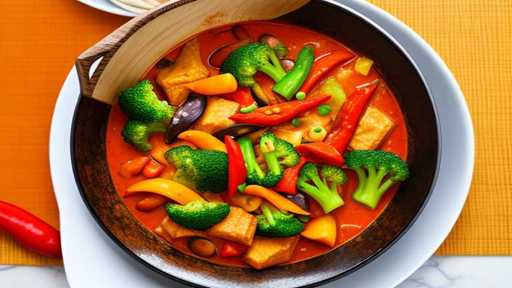
- 1. Jasmine Rice:
- • Soft jasmine rice is a work of art and an independent addition to the rich type of Thai red he curry.
- 2. Coconut Rice:
- • The subtle flavor of coconut rice complements the spiciness of red curry, creating the perfect balance.
- 3. Quinoa:
- • For a better choice, quinoa can be a great alternative. It has a slight nutty flavor and goes well with curry.
- 4. Noodles:
- • Rice noodles or egg noodles are great choices. It absorbs the curry sauce and gives it a special taste.
- 5. Naan or Roti:
- • Indian breads like naan and roti make delicious and unusual additions and provide a different surface.
- 6. Cucumber Salad:
- • A refreshing cucumber salad with a light dressing can add a cooling element to balance the intensity of the curry.
- 7. Mango Salsa:
- • Fruity mango salsa with lime and coriander adds a sweet and tart flavor to spicy curries.
- 8. Steamed Broccoli:
- • Steamed broccoli adds variety and has a slightly crunchy exterior that complements the tender vegetables in the curry.
- 9. Pineapple fried rice:
- • The pleasant flavor of pineapple fried rice and the spiciness of Thai red curry are a perfect balance.
- 10. Lime wedges:
- • Crushing a fresh lime over the curry just before serving adds a lemony newness and enhances the overall flavor.
- 11. Thai Basil Fried Rice:
- • Grilled rice with Thai basil has a particularly natural aroma that enhances the flavor of red curry.
- 12. Coriander Topping:
- • A sprinkling of fresh coriander in a curry adds a burst of herbal flavor and adds variety.
Cooking options for making Thai red curry with vegetables.

- 1. Choose fresh ingredients: Use fresh vegetables for the best flavor and finish. Choose brightly colored vegetables like peppers, broccoli, carrots, and snap peas. Fresh spices like basil and coriander add freshness to the curry.
- 2. High-quality curry paste: Invest your resources in high-quality Thai red curry paste or make your own for an authentic taste. Look carefully at the ingredient list to see if it suits your dietary habits, especially if you have sensitivities or restrictions.
- 3. Taste: Thai cuisine is known for its balance of sweet, hot, hot, and spicy flavors. Taste the curry and adjust the balance according to your mood. You can add sugar for flavor, fish sauce for spiciness, lime juice for spiciness, and a little curry paste for even more spiciness.
- 4. Coconut milk consistency: Before opening the coconut milk bottle, shake the bottle to make sure everything is mixed thoroughly. For a creamier curry, use full-fat coconut milk. If you prefer a lighter option, you can use light coconut milk, or a mixture of both.
- 5. Preparing the vegetables: For proper preparation, cut the vegetables into uniform sizes. If you like your vegetables crunchy, don’t overcook them. If you want the vegetables to be more tender, add them to the curry before cooking.
- 6. Layer the flavors: First, fry the curry paste in oil to release the flavors. Add coconut milk little by little to blend the flavors. Then add vegetables depending on the cooking time so everyone has time and energy to maintain the delicious curry flavor.
- 7. Protein Choice: Refresh your curry with the protein. Tofu, chicken, shrimp, meat, etc. are well known. Adjust the cooking time accordingly so the protein is fully cooked but not overcooked.
- 8. Cropping is important: Think about that last detail. Add flavor and texture to your curry by adding new spices like coriander or Thai basil, a squeeze of lime juice, and a pinch of cracked peanuts.
- 9. Rice Matching: Pair Thai red curry with jasmine rice for an authentic taste experience. You can also try other grains like quinoa or rice noodles for a different twist.
- 10. Leftovers: Thai red curry is often even better when eaten the next day. Store leftovers in a sealed compartment in the refrigerator and gently reheat to preserve flavor.
Serving Ideas for Thai Red Curry with Vegetables:
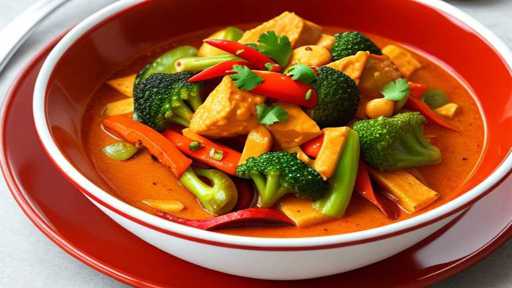
- 1. Presentation:
- • First, spoon the Thai red curry into each bowl, making sure each bowl holds plenty of vegetables and delicious soup.
- • For a show of class, place a small mound of steamed jasmine rice in the center of each bowl, or serve as an afterthought.
- • Refine the curry by adding fresh coriander leaves, thinly sliced green onions and a few limes to add a touch of citrus.
- 2. Garnish:
- • Serving Thai red curry with fragrant jasmine rice preserves the rich flavor of the curry and ensures great taste.
- • Add small rice noodles or vermicelli noodles instead of rice for a great noodle flavor.
- • Customize your small plates by adding additional toppings. For example, add sliced red pepper for those who prefer a stronger flavor, or split peanuts for a crunchy topping.
- 3. Side Dishes:
- • Consider serving Thai cucumber salad as a side dish that adds a refreshing kick to the spice of the curry.
- • Bok choy, broccoli, and baby corn can be steamed or fried to complement curries as an additional vegetable side dish.
- • For those who want more protein for dinner, grilled tofu or shrimp can be offered as protein options.
- 4. Pairing Drinks:
- • Pair Thai red curry with light, fresh drinks such as cold Thai tea or coconut water to adjust the richness of the curry.
- • For those who prefer non-alcoholic fare, citrus-flavored lemonades and refreshing lemongrass-infused drinks can further enhance the overall festival experience.
- 5. The final touch:
- • Chefs encourage squeezing a slice of lime over the curry just before eating, adding an burst of spiciness and novelty to every bite.
- • Provide chopsticks and spoons for a flexible dining experience, allowing visitors to easily enjoy both curry rice or noodles.
Storage and Leftover:
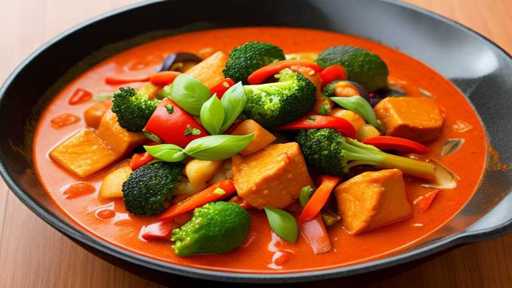
- Storage Location:
- 1. Refrigerate: After eating the delicious Thai Red Curry with Vegetables, immediately store all the additions in a sealed container. please. Place the holder in the refrigerator for approximately 2 hours to ensure hygiene.
- 2. Portioning: To preserve the unique aroma and flavor of curry and rice, store them separately if possible. This prevents the rice from becoming mushy and maintains the optimum consistency of the vegetables and curry.
- 3. Labeling: Consider naming compartments with dates to monitor novelty. Red Thai curry with vegetables can usually be stored in the refrigerator for 2 to 3 days.
- Warm up:
- 1. Burner strategy: For best results, heat the curry on a burner. Place a saucepan over medium heat and add water or coconut milk to prevent burning. Stir until the curry reaches the ideal temperature.
- 2. Microwave Strategy: If you are in a hurry, you can use the microwave. Place the curry in a microwave-safe compartment and stir in 30-second increments to ensure safe heating. Be careful not to overcook as this may damage the surface of the vegetables.
- 3. Warm the rice: If you are storing only the rice, add a few drops of water and warm it to prevent it from drying out. Heat in the microwave or on a burner until it reaches the ideal temperature.
- 4. Check consistency. Whichever method you choose, taste the curry to make sure it’s evenly cooked. Add a pinch of salt, lime juice, or coconut milk to taste and restore flavor, if desired.
- 5. Avoid reheating too many times. To maintain the quality of your food, reheat only the parts you want to eat. Continuing heating cycles can compromise flavor and finish.
Breakdown of the healthy ingredients: Thai Red Curry with Vegetables.
- Thai Red Curry with Vegetables
- • Serving Size: 1 cup (240 ml)
- Calories:
- • Absolute Calories: Approximately 250 kcal
- Macronutrients:
- • Protein: Approximately 5-7 grams
- • Fat: Approximately 15 ~20 grams
- • Fat: approximately 10-12 grams
- • Carbohydrates: approximately 25-30 grams
- • Fiber: approximately 5-7 grams
- • Sugar: approximately 5-7 grams
- Micronutrients:
- • Sodium: approximately 800 ~1000 mg (depending on composition)
- • Nutrients and minerals: Content varies depending on the vegetables used, but may contribute nutrients and minerals. C, potassium etc.
Variation of Thai red curry with vegetables.
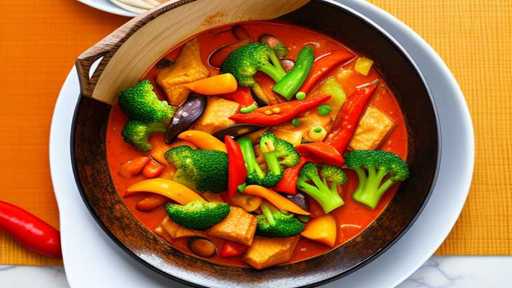
- 1. Increased Protein:
- • Add your favorite protein. Add tofu, chicken, shrimp, meat, etc. for a heartier feast.
- • For a vegan option, try adding chickpeas or tempeh.
- 2. Types of vegetables:
- • For more crunch, experiment with different vegetables such as baby corn, bamboo shoots, and water chestnuts.
- • From time to time, add vegetables or vegetables you particularly like, such as peppers, zucchini, or spinach.
- 3. Change the flavor level:
- • Add a significant amount of Thai red curry gluten to change the spiciness level if desired.
- • You can also reduce the amount of red bean stew peppers for a milder version.
- 4. Coconut Milk Options:
- • For a brighter, creamier topping, replace the coconut milk with coconut cream.
- • If you prefer a lighter version, use coconut milk light or mix coconut milk with vegetable broth.
- 5. Spice Mix:
- • To achieve a particularly sweet flavor, add spices such as lemongrass, kaffir lime leaves, and Thai basil to your curry.
- • You can also create a home-grown version by adding fresh coriander or parsley.
- 6. Nut Extensions:
- • Enhance the topping by adding crushed peanuts or cashews just before serving.
- • Sprinkle roasted coconut drops on top for a great crunch.
- 7. Citrus Ginger:
- • Add lime or lemon ginger to your curry for a novel touch.
- • A squeeze of lime just before serving adds flavor to the dish.
- 8. Rice Type:
- • Serve Thai red curry with another type of rice, such as jasmine rice, rustic rice, or nutritious quinoa.
- 9. Decoration Options:
- • Play around with different ingredients, like sliced green onions, chopped cilantro, and a drizzle of Sriracha for some kick.
- • A pinch of sesame seeds adds a nutty flavor and visual appeal.
- 10. Combination Contest:
- • Use your imagination to combine different food ingredients, such as diced pineapple for a Thai-Hawaiian combination or steamed yams for a Thai-Mexican combination.
Thai Red Curry with Vegetables Recipe Notes:

- 1. Effective Thai Flavor: The use of premium red curry paste ensures the authenticity of this Thai red curry. For authentic flavors, look for brands that include traditional Thai ingredients like lemongrass, galangal, and kaffir lime.
- 2. Vegetable identification: Although the recipe suggests a combination of bell peppers, carrots, and bamboo shoots, feel free to adjust the vegetable selection according to personal preference and availability at the time. Thai eggplant, snow peas, and baby corn also make great additions.
- 3. Coconut milk quality: Choose high quality coconut milk to enhance the smoothness and luxuriousness of the curry. Shake the can before opening to make sure the coconut cream is completely mixed with the milk on top.
- 4. Adjust spiciness: Change the spiciness level according to your preference. If you’re going for a mild curry, start with a small amount of red curry paste and add more as needed. Thai food often balances spiciness with comfort, so consider earth-toned sugars.
- 5. Tofu or Protein Choice: Replace vegetables with tofu or add your favorite protein source like chicken, shrimp, or burgers. Adjust the cooking time accordingly to ensure the protein is fully cooked.
- 6. New spices for refinement: Garnish curries with fresh Thai basil leaves and coriander to enhance flavor. Aromatic spices add a fresh touch to every bite.
- 7. Rice Complement: Eat Thai red curry with steamed jasmine rice and enjoy the delicious sauce. Meanwhile, try rice noodles for a tasty change.
- 8. Social Significance: Thai red curry is a staple of Thai cuisine, known for its ideal combination of fiery, sweet, and exquisite flavours. This reflects the country’s rich culinary tradition, where every preparation is an essential part of a successful dish.
- 9. Pairing Adaptability: This versatile curry pairs well with other Thai dishes, but can also be served on its own for a lively and hearty dinner. Consider serving it as part of a Thai dinner with dishes like cushion thai, tom yum soup, or Thai spring rolls.
- 10. A personal touch: Find different options for recipes and make them your own. Thai cuisine often stimulates the imagination and changes in personal taste. Share this dish with friends and family and create unforgettable memories around the table.
Overall, making a great Thai red curry with vegetables is a culinary experience that guarantees an orchestra of flavors and finishes. This recipe incredibly combines the aromatic flavors of Thai cuisine with the dynamic novelty of grouped vegetables to create a dish that soothes and invigorates the palate.





